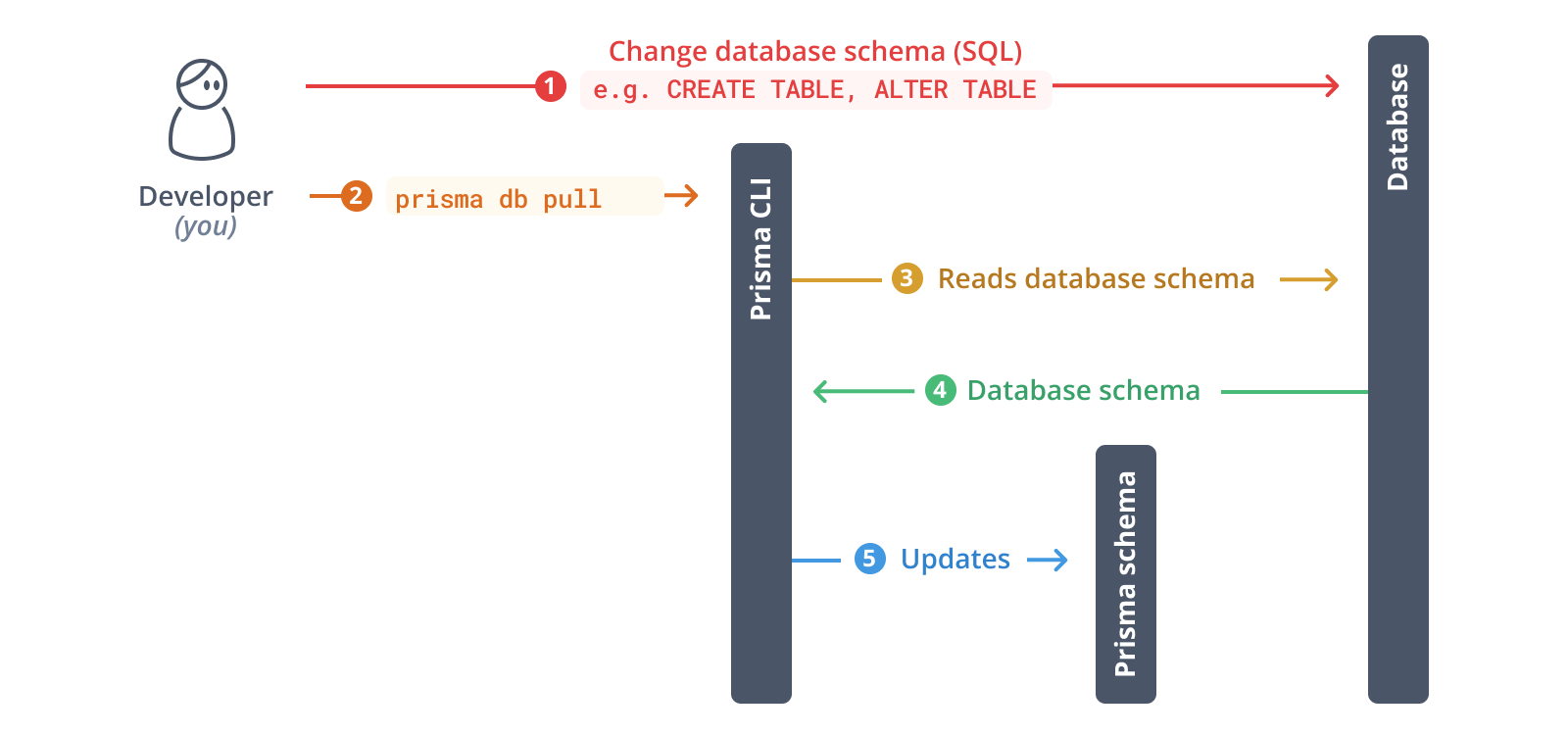在 TypeScript 项目中对 PostgreSQL 进行内省
使用 Prisma ORM 内省您的数据库
为了本指南的目的,我们将使用一个包含三个表的演示 SQL schema
CREATE TABLE "public"."User" (
id SERIAL PRIMARY KEY NOT NULL,
name VARCHAR(255),
email VARCHAR(255) UNIQUE NOT NULL
);
CREATE TABLE "public"."Post" (
id SERIAL PRIMARY KEY NOT NULL,
title VARCHAR(255) NOT NULL,
"createdAt" TIMESTAMP NOT NULL DEFAULT now(),
content TEXT,
published BOOLEAN NOT NULL DEFAULT false,
"authorId" INTEGER NOT NULL,
FOREIGN KEY ("authorId") REFERENCES "public"."User"(id)
);
CREATE TABLE "public"."Profile" (
id SERIAL PRIMARY KEY NOT NULL,
bio TEXT,
"userId" INTEGER UNIQUE NOT NULL,
FOREIGN KEY ("userId") REFERENCES "public"."User"(id)
);
注意:某些字段使用双引号编写,以确保 PostgreSQL 使用正确的字母大小写。如果不使用双引号,PostgreSQL 会将所有内容都读取为小写字符。
展开以查看表的图形概览
User
| 列名 | 类型 | 主键 | 外键 | 必需 | 默认值 |
|---|---|---|---|---|---|
id | SERIAL | ✔️ | 否 | ✔️ | 自动递增 |
name | VARCHAR(255) | 否 | 否 | 否 | - |
email | VARCHAR(255) | 否 | 否 | ✔️ | - |
Post
| 列名 | 类型 | 主键 | 外键 | 必需 | 默认值 |
|---|---|---|---|---|---|
id | SERIAL | ✔️ | 否 | ✔️ | 自动递增 |
createdAt | TIMESTAMP | 否 | 否 | ✔️ | now() |
title | VARCHAR(255) | 否 | 否 | ✔️ | - |
content | TEXT | 否 | 否 | 否 | - |
published | BOOLEAN | 否 | 否 | ✔️ | false |
authorId | INTEGER | 否 | ✔️ | ✔️ | - |
Profile
| 列名 | 类型 | 主键 | 外键 | 必需 | 默认值 |
|---|---|---|---|---|---|
id | SERIAL | ✔️ | 否 | ✔️ | 自动递增 |
bio | TEXT | 否 | 否 | 否 | - |
userId | INTEGER | 否 | ✔️ | ✔️ | - |
接下来,您将内省您的数据库。内省的结果将是 Prisma schema 中的一个数据模型。
运行以下命令来内省您的数据库
npx prisma db pull
此命令读取 .env 中定义的 DATABASE_URL 环境变量并连接到您的数据库。连接建立后,它会内省数据库(即读取数据库 schema)。然后它将数据库 schema 从 SQL 转换为 Prisma schema 中的数据模型。
内省完成后,您的 Prisma schema 已更新

数据模型现在看起来与此类似(请注意,模型上的字段已重新排序以提高可读性)
model Post {
id Int @id @default(autoincrement())
title String @db.VarChar(255)
createdAt DateTime @default(now()) @db.Timestamp(6)
content String?
published Boolean @default(false)
authorId Int
User User @relation(fields: [authorId], references: [id], onDelete: NoAction, onUpdate: NoAction)
}
model Profile {
id Int @id @default(autoincrement())
bio String?
userId Int @unique
User User @relation(fields: [userId], references: [id], onDelete: NoAction, onUpdate: NoAction)
}
model User {
id Int @id @default(autoincrement())
name String? @db.VarChar(255)
email String @unique @db.VarChar(255)
Post Post[]
Profile Profile?
}
Prisma ORM 的数据模型是您的数据库 schema 的声明性表示,并作为生成的 Prisma Client 库的基础。您的 Prisma Client 实例将公开根据这些模型量身定制的查询。
目前,数据模型存在一些小“问题”
User关系字段采用大写,因此不符合 Prisma 的命名约定。为了表达更多“语义”,如果此字段名为author以更好地描述User和Post之间的关系,那也会很好。User上的Post和Profile关系字段以及Profile上的User关系字段都采用大写。为了遵循 Prisma 的命名约定,这两个字段都应该小写为post、profile和user。- 即使小写后,
User上的post字段仍略有命名错误。这是因为它实际上指的是一个帖子的列表——因此更好的名称应该是复数形式:posts。
这些更改对于生成的 Prisma Client API 很重要,在其中使用小写关系字段 author、posts、profile 和 user 会让 JavaScript/TypeScript 开发者感觉更自然、更地道。因此,您可以配置您的 Prisma Client API。
由于关系字段是虚拟的(即它们不会直接在数据库中体现),因此您可以在 Prisma schema 中手动重命名它们,而无需更改数据库
model Post {
id Int @id @default(autoincrement())
title String @db.VarChar(255)
createdAt DateTime @default(now()) @db.Timestamp(6)
content String?
published Boolean @default(false)
authorId Int
author User @relation(fields: [authorId], references: [id], onDelete: NoAction, onUpdate: NoAction)
}
model Profile {
id Int @id @default(autoincrement())
bio String?
userId Int @unique
user User @relation(fields: [userId], references: [id], onDelete: NoAction, onUpdate: NoAction)
}
model User {
id Int @id @default(autoincrement())
name String? @db.VarChar(255)
email String @unique @db.VarChar(255)
posts Post[]
profile Profile?
}
在此示例中,数据库 schema 确实遵循了 Prisma ORM 模型的命名约定(只有从内省生成的虚拟关系字段不符合约定,需要调整)。这优化了生成的 Prisma Client API 的人体工程学。
使用自定义模型和字段名称
不过,有时您可能希望对 Prisma Client API 中公开的列名和表名进行额外更改。一个常见的例子是将数据库 schema 中常用的snake_case表示法转换为对 JavaScript/TypeScript 开发者而言更自然的PascalCase和camelCase表示法。
假设您从内省中获得了以下基于snake_case表示法的模型
model my_user {
user_id Int @id @default(autoincrement())
first_name String?
last_name String @unique
}
如果您为这个模型生成 Prisma Client API,它将在其 API 中采用snake_case表示法
const user = await prisma.my_user.create({
data: {
first_name: 'Alice',
last_name: 'Smith',
},
})
如果您不想在 Prisma Client API 中使用数据库中的表名和列名,您可以使用@map 和 @@map 进行配置。
model MyUser {
userId Int @id @default(autoincrement()) @map("user_id")
firstName String? @map("first_name")
lastName String @unique @map("last_name")
@@map("my_user")
}
通过这种方法,您可以随意命名您的模型及其字段,并使用 @map(用于字段名)和 @@map(用于模型名)指向底层表和列。您的 Prisma Client API 现在看起来如下:
const user = await prisma.myUser.create({
data: {
firstName: 'Alice',
lastName: 'Smith',
},
})
在配置您的 Prisma Client API 页面了解更多信息。